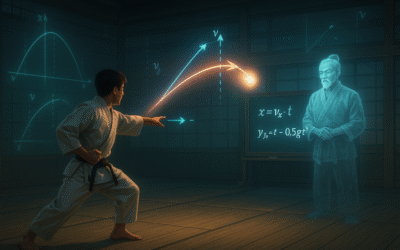🥋 Circular Motion and Centripetal Force – White to Black Belt Mastery
“To move in a circle, something must always pull you inward.”
White Belt Level – Key Concept
Circular motion happens when an object travels around a circle at constant speed.
Even if speed stays the same, the direction changes, so there is acceleration.
That inward acceleration is called centripetal acceleration, caused by a centripetal force.
In simple words: Circles need inward pull.
🎮 Explore: PhET Simulation – Ladybug Revolution
Core Principles
- Uniform circular motion = constant speed, changing direction.
- Acceleration always points toward the center.
- Centripetal force is not a new type of force—it’s the name for the net inward force.
- Examples: tension in a string, friction in a car turn, gravity in planetary orbits.
📖 Learn more: OpenStax University Physics, Ch. 6.2
Key Equations (SI Units)
- Centripetal acceleration: a_c = v² / r (m/s²)
- Centripetal force: F_c = m v² / r (N)
- Velocity: v = 2πr / T (T = period in seconds)
📄 Reference: OpenStax – Physics Formula Appendix
Common Mistakes and Pitfalls
- Thinking “centrifugal force” pushes outward (it’s not real—it’s inertia).
- Forgetting that centripetal force is provided by tension, friction, or gravity.
- Confusing linear speed with angular speed.
🔎 See also: HyperPhysics – Circular Motion
Sensei’s Shortcuts
🎢 Tight Turn Rule: Smaller radius = bigger inward force needed. That’s why sharp turns at high speed are dangerous.
Worked Example – Step by Step (White Belt)
Problem: A 1,000 kg car makes a turn of radius 50.0 m at 10.0 m/s. What centripetal force is required?
Step 1. Formula:
F_c = m v² / r
Step 2. Substitution:
F_c = (1,000)(10.0²) / 50.0
Step 3. Solve:
F_c = 1,000 × 100 / 50.0 = 2,000 N
Step 4. Final Answer:
F_c = 2,000 N
Practice Drill (White Belt)
- A 2.00 kg ball on a 1.50 m string moves at 4.00 m/s. Find F_c.
Answer: 21.3 N - A 500 kg roller coaster moves at 15.0 m/s on a curve of radius 20.0 m. Find F_c.
Answer: 5,630 N
Yellow Belt Extension – Deeper Skills
Problem: A satellite orbits Earth at radius 7.00 × 10⁶ m with speed 7,500 m/s. Find its centripetal acceleration.
Solution Outline:
a_c = v² / r
= (7,500²) / (7.00 × 10⁶)
= 56.3 m/s²
Final Answer: a_c = 56.3 m/s²
🎮 Try adjusting radius and speed in PhET Ladybug Revolution.
📖 Extra reading: Khan Academy – Centripetal Force
Black Belt Mastery – Exam Strategy and Challenge
Challenge Problem: A 1,200 kg car makes a turn of radius 30.0 m at 20.0 m/s. The coefficient of static friction between tires and road is 0.70. Will the car skid?
Strategy Notes:
- F_required = m v² / r
- F_max = μ_s m g
- Compare required with maximum.
Solution:
F_required = (1,200)(20.0²) / 30.0
= 1,200 × 400 / 30.0 = 16,000 N
F_max = μ_s m g = 0.70 × 1,200 × 9.81 = 8,240 N
Since F_required > F_max, the car skids.
Final Answer:
Yes, the car will skid because friction is not enough.
🚀 Related: NASA – Orbits and Circular Motion
Sensei’s Final Words
Circular motion hides a secret: it always demands an inward force. Whether it’s a car on a turn, a planet in orbit, or you on a roller coaster—physics is always pulling you back to center.


0 Comments